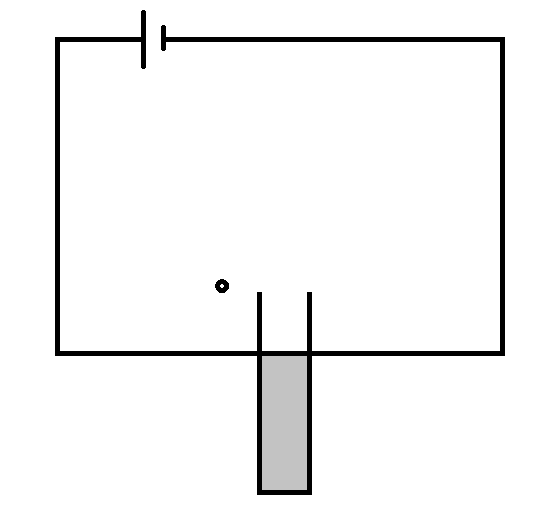Question
Question: A dielectric slab of dielectric constant \( k \) , mass \( m \) , thickness \( d \) , and area \( L ...
A dielectric slab of dielectric constant k , mass m , thickness d , and area L×L is hanging vertically in equilibrium under the influence of gravity and electrostatic pull of a capacitor connected to a battery of voltage V . The capacitor has plates of area L×L and distance between plates is d . The capacitor is half-filled by the dielectric. Suddenly a mass of m is attached to the dielectric without any impulse on the system. The slab falls off in time t . Evaluate t (in a sec). Take k=2 , V=4volts , L=80cm , d=0.1mm .

Solution
We will first evaluate the new capacitance after the dielectric is inserted in it. Then using that capacitance we will evaluate the electrostatic pull due to the battery and using these parameters and given quantities we will evaluate the time the slab falls off when some mass is introduced without any impulse.
Formula used:
The formula of the capacitance
⇒C=dkE0xL
Electrostatic potential energy formula
⇒U=21CnewV2
Electrostatic force
⇒FE=−dxdU .
Complete step by step solution:
Suppose at any point x , the length L of the dielectric is inserted between the capacitor C .
Hence the new capacitance will be given as
⇒Cnew=C1+C2
⇒Cnew=dE0(L−x)L+dkE0xL
where d is the dielectric constant and L is the length of the dielectric introduced.
⇒Cnew=dE0L(L−x(1−k))
⇒Cnew=dE0L(L+x(k−1)) ………. (1)
Now using this dielectric we will evaluate the potential energy which can be given by U , hence
⇒U=21CnewV2
Substituting the value of capacitance from the equation (1) , we get
⇒U=21[dE0L(L+x(k−1))]V2 ………. (1)
We know that the electrostatic pull is acting due to battery of voltage V which can be given as
⇒FE=−dxdU
Hence differentiating the equation (2) with respect to x what we get,
⇒FE=−dxd(21[dE0L(L+x(k−1))]V2)
⇒FE=−21E0L(k−1)V2
Also given that this electrostatic force equals to gravity acting on the dielectric which results as
⇒FE=mg
Hence on comparing it
⇒mg=21E0L(k−1)V2 ……… (3)
Now the Net force Fnet=ma can be given as by the difference between the initial condition FE of the dielectric and its final condition 2FE ,
⇒Fnet=2FE−FE
⇒Fnet=21E0L(k−1)V2
Hence the acceleration can be given as
⇒ma=21E0L(k−1)V2
⇒a=21mE0L(k−1)V2 ……… (4)
Form equation (3) we can conclude the value of mass m as
⇒mg=21E0L(k−1)V2
⇒m=21gE0L(k−1)V2
Substituting it in the equation (4) , we get
⇒a=21(21gE0L(k−1)V2)E0L(k−1)V2
∴a=g
Now the slab is half-filled with dielectric hence the height of the dielectric H will be given as
⇒H=2L=20.8=0.4
Now evaluating the time by the formula for H height and g=10m/s2
⇒t=g2H
⇒t=102×0.4
∴t=0.29sec
Hence the time the slab falls off when some mass is introduced without any impulse is t=0.29sec .
Note:
Dielectric is a material that is insulating. In other words it is a very poor conductor of electricity. When we place dielectrics in the electric fields, then current flows through them practically as they don’t have free electrons and loose bounds.
